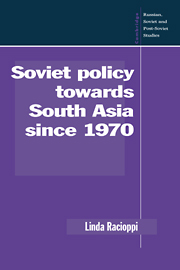Book contents
- Frontmatter
- Contents
- List of tables
- Acknowledgments
- 1 Introduction: South Asia in the USSR's Third World policy
- 2 Soviet perceptions of the Third World and South Asia
- 3 The Soviet Union in South Asia: objectives and instruments
- 4 Stability and change in Soviet–South Asian relations, 1970–1978
- 5 Soviet–South Asian relations in the wake of Afghanistan, 1978–1985
- 6 Soviet Policy towards South Asia in the Gorbachev era
- 7 Conclusion
- Notes
- Index
- Soviet and East European Studies
1 - Introduction: South Asia in the USSR's Third World policy
Published online by Cambridge University Press: 15 December 2009
- Frontmatter
- Contents
- List of tables
- Acknowledgments
- 1 Introduction: South Asia in the USSR's Third World policy
- 2 Soviet perceptions of the Third World and South Asia
- 3 The Soviet Union in South Asia: objectives and instruments
- 4 Stability and change in Soviet–South Asian relations, 1970–1978
- 5 Soviet–South Asian relations in the wake of Afghanistan, 1978–1985
- 6 Soviet Policy towards South Asia in the Gorbachev era
- 7 Conclusion
- Notes
- Index
- Soviet and East European Studies
Summary
When Nikita Khrushchev plunged the Soviet Union into the Third World, two of the countries he chose to visit on his well publicized 1955 trip to the Third World were Afghanistan and India. Since that time, South Asia (which for the purposes of this study includes Afghanistan, Bangladesh, India, Nepal, Pakistan, and Sri Lanka) remained a critical area for the USSR's security interests and objectives in the Third World. The region was the site of political, military, and economic competition between the Soviet Union, the United States, and China; two countries of the region (Afghanistan and India again) were among the USSR's top ten non-communist Third World trade partners; the region was second only to the Middle East in Soviet arms transfers and received large amounts of Soviet development assistance. Even with the end of the Cold War, geography still made South Asia, an economically underdeveloped, politically unstable region, a concern to an economically weary and politically unstable Soviet Union. Relations between the regional hegemon India, and Pakistan stabilized after the 1971 war, but the competition between the two remained; secessionist movements in many countries threatened the precarious regional stability; success in economic development was uneven at best; and most critical for the USSR and its successor states, the crisis in Afghanistan continued despite the pull-out of Soviet troops and the US–Soviet agreement to end military aid to the contending sides.
- Type
- Chapter
- Information
- Soviet Policy towards South Asia since 1970 , pp. 1 - 10Publisher: Cambridge University PressPrint publication year: 1994



